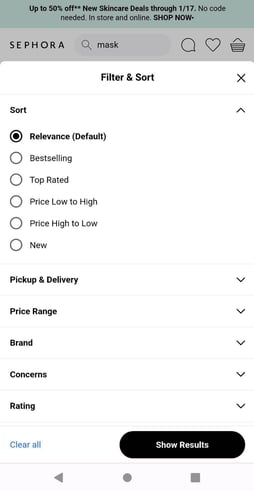CRO Practice Lead
How to drive sales for your online business with e-merchandising
CRO Practice Lead
Want to be less dependent on media investments while maximizing your e-commerce platform’s conversion rate?
In this new series of articles, we’ll explore the field and goals of e-merchandising, as well as a few techniques borrowed from brick-and-mortar stores that you can copy to increase sales on your e-comm platform.
To get started, we’ll focus on customers’ access to products sold online. The point here is a simple yet effective one: Wider accessibility to merchandise improves the likelihood that customers will add items to their shopping carts and, therefore, the likelihood that you’ll earn a sale.
But first, let’s get into the theory!
E-merchandising definition
E-merchandising (or e-commerce merchandising) is a way of compensating for the lack of a salesperson at an online business by offering the right product in the right place to the right person, which somewhat mimics the personalized service provided by salespeople in physical stores.
It’s a tool that enables you to both optimize the user journey through browsing experience personalization and improve revenue on your transactional site (conversion rate, average cart value, sales revenue, inventory, margin, etc.).
In more concrete terms, e-merchandising organizes how products are displayed using a product category page list so that more relevant items are highlighted and quickly shown to people who are likely to be interested in them. E-merchandising also covers product recommendations through cross-selling and results shown by internal search engines.
Facilitating access to desired products
It simply comes down to logic: If you can’t find a product, you can’t buy it! Salespeople serve to facilitate customers’ access to available products from the business and encourage discoverability. When done well, e-merchandising can improve the rate at which items are added to carts online and, further along in the journey, have a positive effect on the conversion rates of online businesses.
The first step is creating a navigation menu that’s clear and exhaustive. At a single glance, it must present all products available to customers, the goal being to quickly direct users to what they’re looking for in categorized pages or product lists.
On Oh My Cream, the product range is well organized and combines striking clarity with exhaustive coverage. Highlighted products are also presented in the second layer of the browsing menu to direct customers to the product.
Automated sorting rules and search filters
However, simply directing users to the product category page isn’t enough! Ensure you offer each person relevant products (above the fold, if possible) that respond to their interests or needs from the moment they land on the page. To organize products according to targeted attributes (for example, promoting products with high margins or a lot of inventory, bestsellers and products with the best conversion rate and/or by user behaviour in real time based on viewed products, typed searches, purchase history, etc.), you’ll need to implement automated sorting rules.
Also offer your customers the possibility of refining the product offering (which could be huge) through specific filters. Filters allow people to view a more circumscribed list that only displays products that respond to certain search criteria or which have a particular characteristic. To illustrate the idea, here are a few examples of filters and sorting rules.
On the page “Insulated Coats and Vests,” Altitude offers filters that are specific to their customers. As you can see in the screenshot above, the company considers the needs of platform users, as well as the different contexts in which its clothing might be worn (which influences search criteria), such as the activities these items are suited for, the desired degree of thermal insulation, how waterproof they are, etc

On Sephora, online customers are offered a selection of sorting rules. These allow users to adjust the product display order so the products that best fit their search criteria (for example, Top Rated, New, Price Low to High, etc.) are presented first.
The internal search engine: An often underestimated tool!
Another tool to facilitate access to products that shouldn’t be overlooked is the internal search engine.
According to the results of a study presented by AddSearch, this tool was used on average by 15% of visitors to e-commerce sites, but this limited share of the site’s visitors had a huge positive impact on sales for an e-commerce platform, generating 45% of its revenue. A second study confirms the crucial importance of this tool. According to Searchspring, there is a clearly higher conversion rate (sometimes four-fold!) amongst users who take advantage of the internal search engine than amongst browsers, or those users who mostly use navigation menus and pages divided by category during their online shopping sessions.
The internal search engine of an online sales platform is therefore a precious resource, since the people who use it already have a specific idea of what they’re looking for and are already inclined to make a purchase!
Here are the key components of this powerful feature. You should put some consideration into them to maximize your search engine’s effectiveness.
a) Design
The search bar should contrast with the visual environment of your platform so that it’s easy to find and access from any page of your site. You also need to respect best practices in terms of webpage design by integrating:
-
a short text inviting users to search for something;
-
a magnifying glass to launch the search; and
In the image above, we can see that Calvin Klein provides an attractive and efficient search bar that respects the best practices in web design mentioned earlier. The search field also remains fixed in place when the user scrolls the page’s contents on a mobile device.
b) Behaviour
Ideally, results will be displayed in a clear, well-organized manner within the search bar from the moment the user begins typing a search, thanks to the autocomplete feature. Results suggested via autocomplete must also appear quickly and be modified (refined, adapted, updated) with each new character added in the search field.
The internal search bar on the platform Blissim suggests results organized by brand, category, product and tips. Products displayed are updated quickly with each new character entered.
c) Results page
Here again, filters and sorting rules are offered on search result pages, as with your category and listing pages (see previous examples).
Ensure that the results suggested are relevant to the search entered. You can easily perform a series of tests yourself by entering the most popular requests found on your analytics report into the search field.
Don’t forget to speak your user’s language! The search engine should be tolerant of spelling mistakes and mistaken keystrokes, which often occur, and suggest results even if the keyword entered into the search engine contains mistakes. This will avoid displaying a “No results” message, which might frustrate your users.
Amazon generates results even when words are mistyped (here “Macbok air” instead of “MacBook Air”).
d) “No results” page
It could happen that the search engine is not able to display any results, particularly if the product being searched for isn’t offered on your site or is temporarily out of stock. In such a case, try to “reacquire” the customers and encourage them not to leave your site by suggesting products even when the search engine doesn’t find anything matching the request. This could be accomplished by highlighting your bestsellers or latest products, for example.
Skinceuticals displays its bestsellers when a keyword generates no result in the platform’s internal search engine.
An ounce of prevention is worth a pound of cure! Try to systematically identify requests that generate no result. You can do this through your data analytics tools or by consulting the dashboard of the tool you’re using to optimize your search engine. With the information you find there, you can then adjust your internal search engine by creating synonyms, redirecting to similar products or some other strategy that suits your objectives.
*
In this first article we’ve covered five tools for facilitating access to products: the navigation menu, automated sorting into a page list, filters, sorting rules made available to users and the internal search engine. Try a few of these ideas and see how they work for your business. Every technique you apply to attract more customers to your site and to offer a better purchase experience might just increase your sales.
If you need personalized support with this issue, don’t hesitate to get in touch with our specialists.

.png)











